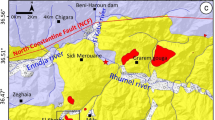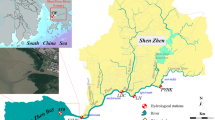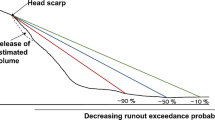Abstract
The Wenchuan earthquake strongly disturbed the earth surface and induced sufficient loose debris in the mountain basin, which supplies sufficient solid materials for debris flow initiation. Recently, a catastrophic debris flow was induced by strong rainfall on June 26, 2023 in the Banzi basin. Inconsistent with the first few years of the Wenchuan earthquake, the hillslope landslide sediment supply for debris flow occurrence is limited after 15 years of the Wenchuan earthquake, and the materials supplied for debris flow in the later period are mainly obtained from alluvium deposited along the channel. Simultaneously, this debris flow was triggered by flash flood through strongly erosion channel materials. However, although 15 years have passed since the Wenchuan earthquake, the triggering rainfall conditions have still not returned to pre-earthquake level. This debris flow first initiated in the upper branches of the basin and then gradually transported downstream at an average discharge of 806.99 m3/s, and approximately 82.80 × 104 m3 solid materials were transported out the Banzi basin to form a debris flow fan with length of 120 m and width of 260 m in the Minjiang River, which poses a serious threat to the resettled population and destroy the reconstruction infrastructures. Importantly, there are still sufficient solid materials deposited in the basin, this could result in debris flow activity continuing for an unpredictable time. Therefore, implementation early warning, prevention, and mitigation measures in this basin are still important for debris flow disaster management in the later period of Wenchuan earthquake.

















Similar content being viewed by others
References
Chen M, Tang C, **ong J, Shi QY, Li N, Gong LF, Wang XD, Tie Y (2020) The long-term evolution of landslide activity near the epicentral area of the 2008 Wenchuan earthquake in China. Geomorphology 367:107317. https://doi.org/10.1016/j.geomorph.2020.107317
Chen M, Tang C, Li M, **ong J, Luo Y, Shi Q, Zhang X, Tie Y, Feng Q (2022) Changes of surface recovery at coseismic landslides and their driving factors in the Wenchuan earthquake-affected area. Catena 210:105871. https://doi.org/10.1016/j.catena.2021.105871
Chen M, Tang C, ** and long-term evolution of debris flow activity after a high magnitude earthquake. Catena 236:107716. https://doi.org/10.1016/j.catena.2023.107716
Chigira M, Wu X, Inokuchi T, Wang G (2010) Landslides induced by the 2008 Wenchuan earthquake, Sichua, China. Geomorphology 118(3–4):225–238. https://doi.org/10.1016/j.geomorph.2010.01.003
Dadson SJ, Hovius N, Chen H, Dade WB, Lin JC, Hsu ML, Lin CW, Horng MJ, Chen TC, Milliman J, Stark CP (2004) Earthquake-triggered increase in sediment delivery from an active mountain belt. Geology 32(8):733–736. https://doi.org/10.1130/G20639.1
Fan CC, Su CF (2008) Role of roots in the shear strength of root-reinforced soils with high moisture content. Ecol Eng 33(2):157–166. https://doi.org/10.1016/j.ecoleng.2008.02.013
Fan RL, Zhang LM, Wang HJ, Fan XM (2018) Evolution of debris flow activities in Gaojiagou Ravine during 2008–2016 after the Wenchuan earthquake. Eng Geol 235:1–10. https://doi.org/10.1016/j.enggeo.2018.01.017
Fan X, Scaringi G, Korup O, West AJ, Westen CJ, Tanyas H, Hovius N, Hales TC, Jibson RW, Allstadt KE, Zhang L, Evans SG, Xu C, Li G, Pei X, Xu Q, Huang RQ (2019) Earthquake-induced chains of geologic hazards: patterns, mechanisms, and impacts. Rev Geophys 57(2):421–503. https://doi.org/10.1029/2018RG000626
Ge YG, Cui P, Zhang JQ, Zeng C, Su FH (2015) Catastrophic debris flows on July 10th 2013 along the Min River in areas seriously-hit by the Wenchuan earthquake. J Mt Sci 12(1):186–206. https://doi.org/10.1007/s11629-014-3100-7
Gorum T, Fan X, van Westen CJ, Huang RQ, Xu Q, Tang C, Wang G (2011) Distribution pattern of earthquake-induced landslides triggered by the 12 May 2008 Wenchuan earthquake. Geomorphology 133(3–4):152–167. https://doi.org/10.1016/j.geomorph.2010.12.030
Hovius N, Meunier P, Lin CW, Chen H, Chen YG, Dadson S, Horng MJ, Lines M (2011) Prolonged seismically induced erosion and the mass balance of a large earthquake. Earth Planet Sc Lett 304(3–4):347–355. https://doi.org/10.1016/j.epsl.2011.02.005
Huang RQ, Li WL (2014) Post-earthquake landsliding and long-term impacts in the Wenchuan earthquake area, China. Eng Geol 182:111–120. https://doi.org/10.1016/j.enggeo.2014.07.008
Keefer DK (1994) The importance of earthquake-induced landslides to long-term slope erosion and slope-failure hazards in seismically active regions. Geomophology 10:265–284. https://doi.org/10.1016/0169-555X(94)90021-3
Ma C, Hu K, Zou Q, Tian M (2013) Characteristics of clustering debris flows in Wenchuan earthquake zone. J Mt Sci 10(6):953–961. https://doi.org/10.1007/s11629-013-2410-5
Marino P, Subramanian SS, Fan X, Greco R (2022) Changes in debris-flow susceptibility after the Wenchuan earthquake revealed by meteorological and hydro-meteorological thresholds. Catena 210:105929. https://doi.org/10.1016/j.catena.2021.105929
Medwedeff WG, Clark MK, Zekkos D, West AJ (2020) Characteristic landslide distributions: an investigation of landscape controls on landslide size. Earth Planet Sc Lett 539:116203. https://doi.org/10.1016/j.epsl.2020.116203
Mikoš M, Fazarinc R, Ribičič M (2006) Sediment production and delivery from recent large landslides and earthquake-induced rock falls in the Upper Soča River Valley. Slovenia Eng Geol 86(2–3):198–210. https://doi.org/10.1016/j.enggeo.2006.02.015
Shen P, Zhang LM, Fan R, Zhu H, Zhang S (2020) Declining geohazard activity with vegetation recovery during first ten years after the 2008 Wenchuan earthquake. Geomorphology 352:106989. https://doi.org/10.1016/j.geomorph.2019.106989
Shi Q, Tang C, Gong L, Chen M, Li N, Zhou W, **ong J, Tang H, Wang X, Li M (2021) Activity evolution of landslides and debris flows after the Wenchuan earthquake in the Qipan catchment, Southwest China. J Mt Sci 18(4):932–951. https://doi.org/10.1007/s11629-020-6494-4
Tan WP, Hen QY (1992) Study on regional critical rainfall induced debris flow in Sichuan Province. Journal of Catastrophology 7:37–42 (in Chinese)
Tang C, Zhu J, Li WL, Liang JT (2009) Rainfall-triggered debris flows following the Wenchuan earthquake. B Eng Geol Environ 68(2):187–194. https://doi.org/10.1007/s10064-009-0201-6
Tang C, Rengers N, van Asch TWJ, Yang YH, Wang GF (2011a) Triggering conditions and depositional characteristics of a disastrous debris flow event in Zhouqu city, Gansu Province, northwestern China. Nat Hazard Earth Sys 11(11):2903–2912. https://doi.org/10.5194/nhess-11-2903-2011
Tang C, Zhu J, Ding J, Cui XF, Chen L, Zhang JS (2011b) Catastrophic debris flows triggered by a 14 August 2010 rainfall at the epicenter of the Wenchuan earthquake. Landslides 8(4):485–497. https://doi.org/10.1007/s10346-011-0269-5
Tang C, Zhu J, Qi X, Ding J (2011c) Landslides induced by the Wenchuan earthquake and the subsequent strong rainfall event: a case study in the Beichuan area of China. Eng Geol 122(1–2):22–33. https://doi.org/10.1016/j.enggeo.2011.03.013
Tang C, van Asch TWJ, Chang M, Chen GQ, Zhao XH, Huang XC (2012) Catastrophic debris flows on 13 August 2010 in the Qing** area, southwestern China: the combined effects of a strong earthquake and subsequent rainstorms. Geomorphology 139–140:559–576. https://doi.org/10.1016/j.geomorph.2011.12.021
Tang C, Westen CJV, Tanyaş H, Jetten VG (2016) Analysing post-earthquake landslide activity using multi-temporal landslide inventories near the epicentral area of the 2008 Wenchuan earthquake. Nat Hazard Earth Sys 16(12):2641–2655. https://doi.org/10.5194/nhess-16-2641-2016
Wang J, ** ZD, Hilton RG, Zhang F, Densmore AL, Li G, West AJ (2015) Controls on fluvial evacuation of sediment from earthquake-triggered landslides. Geology 43(2):115–118. https://doi.org/10.1130/G36157.1
**ong J, Tang C, Chen M, Gong L, Li N, Zhang X, Shi Q (2021a) Long-term changes in the landslide sediment supply capacity for debris flow occurrence in Wenchuan County, China. Catena 203:105340. https://doi.org/10.1016/j.catena.2021.105340
**ong J, Tang C, Chen M, Zhang XZ, Shi QY, Gong LF (2021b) Activity characteristics and enlightenment of the debris flow triggered by the rainstorm on 20 August 2019 in Wenchuan County, China. B Eng Geol Environ 80(2):873–888. https://doi.org/10.1007/s10064-020-01981-x
**ong J, Tang C, Gong L, Chen M (2021c) Variability of rainfall time distributions and their impact on peak discharge in the Wenchuan County, China. B Eng Geol Environ 80(9):7113–7129. https://doi.org/10.1007/s10064-021-02376-2
**ong J, Tang C, Gong L, Chen M, Li N, Shi Q, Zhang X, Chang M, Li M (2022a) How landslide sediments are transferred out of an alpine basin: evidence from the epicentre of the Wenchuan earthquake. Catena 208:105781. https://doi.org/10.1016/j.catena.2021.105781
**ong J, Tang C, Tang H, Chen M, Zhang X, Shi Q, Chang M, Gong L, Li N, Li M (2022b) Long-term hillslope erosion and landslide-channel coupling in the area of the catastrophic Wenchuan earthquake. Eng Geol 305:106727. https://doi.org/10.1016/j.enggeo.2022.106727
**ong J, Chen H, Tang C, Chen M, Chang M, Zhang X, Gong L, Li N, Shi Q, Li M (2023) Application of remote sensing monitoring to the spatiotemporal variation in debris flow activity in the catastrophic Wenchuan seismic area. Catena 232:107450. https://doi.org/10.1016/j.catena.2023.107450
Yunus AP, Fan X, Tang X, Jie D, Xu Q, Huang R (2020) Decadal vegetation succession from MODIS reveals the spatio-temporal evolution of post-seismic landsliding after the 2008 Wenchuan earthquake. Remote Sens Environ 236:111476. https://doi.org/10.1016/j.rse.2019.111476
Zhang YS, Cheng YL, Yin YP, Lan HX, Wang J, Fu XX (2014) High-position debris flow: a long-term active geohazard after the Wenchuan earthquake. Eng Geol 180:45–54. https://doi.org/10.1016/j.enggeo.2014.05.014
Zhang S, Zhang L, Lacasse S, Nadim F (2016) Evolution of mass movements near epicentre of Wenchuan Earthquake, the first eight years. Sci Rep 6:36154. https://doi.org/10.1038/srep36154
Zhang X, Tie Y, Ning N, Yang C, Li Z, Li M (2023) Characteristics and activity analysis of the catastrophic “6·26” debris flow in Banzi catchment, Wenchuan County, Sichuan Province. Hydrogeol Eng Geol 50(5):134–145. https://kns.cnki.net/kcms2/detail/11.2202.P.20230711.1957.002.html. (In Chinese)
Zhou W, Tang C (2014) Rainfall thresholds for debris flow initiation in the Wenchuan earthquake-stricken area, southwestern China. Landslides 11(5):877–887. https://doi.org/10.1007/s10346-013-0421-5
Funding
This research was financially supported by the National Natural Science Foundation of China (grant no. U21A2008, 42301099), the Second Tibetan Plateau Scientific Expedition and Research Program (STEP) (grant no. 2019QZKK0902), the CAS Light of West China Program, Special Research Assistant Program of the Chinese Academy of Sciences (grant no. E3R2150), the Science and Technology Research Program of Institute of Mountain Hazards and Environment, Chinese Academy of Sciences (IMHE-ZDRW-02), and the Natural Science Foundation of Sichuan Province (grant no. 2023NSFSC0809).
Author information
Authors and Affiliations
Corresponding author
Ethics declarations
Conflict of interest
The authors declare no competing interests.
Rights and permissions
Springer Nature or its licensor (e.g. a society or other partner) holds exclusive rights to this article under a publishing agreement with the author(s) or other rightsholder(s); author self-archiving of the accepted manuscript version of this article is solely governed by the terms of such publishing agreement and applicable law.
About this article
Cite this article
Chen, H., **ong, J., Zhao, W. et al. Catastrophic debris flow triggered by a June 26, 2023 rainstorm suggests the debris flow is still active 15 years after the Wenchuan seismic. Landslides (2024). https://doi.org/10.1007/s10346-024-02279-9
Received:
Accepted:
Published:
DOI: https://doi.org/10.1007/s10346-024-02279-9




